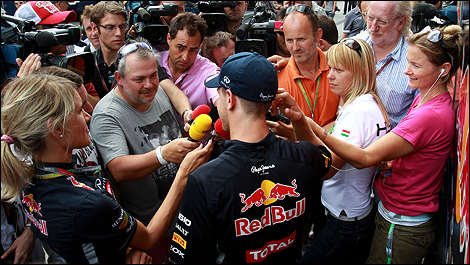Aug
23rd
Stay connected Subscribe to our RSS feed
As a professional auto racing journalist, I am often asked: ''So, you must be spending a lot of time with the drivers, right?''
Honestly, I don't know how to answer. Yes, it's part of the job, but I can assure you that it has become more of a hide-and-seek game in recent years.
Most Formula 1, IndyCar and NASCAR drivers do not particularly enjoy life in the paddocks. They feel too vulnerable to autograph seekers, fans, groupies, photographers, and the media.
Take NASCAR for example: Drivers usually make a beeline for their team's garage and motor home, preferably in a golf cart so as to move faster than people chasing them on foot.
In order to meet a driver and get an interview, one must normally go through their PR staff. However, in NASCAR, there's a whole sea of them -- one for the team, one for the sponsor, another for the driver himself, etc. That's a lot of folks, and oftentimes they don't communicate with each other. You can be granted a request, only to have it denied moments later by someone else. It happened to me back in April during a DTM race.
Last summer, I knew that Andrew Ranger was competing in the NAPA 200 in Montreal, but I never even saw him. And just try to talk to Jacques Villeneuve when he's in the paddocks; it's like ''Where's Waldo?''
Formula 1 has smaller quarters for drivers to ''hide'' in, so it's easier to stumble upon them. If they're not in too much of a hurry, they will agree to share a few words with you.
Of course, those pesky PR guys and gals quickly step in, like the control freaks that they are. Anytime you interview a member of a racing team, they stand nearby and record the whole conversation. Why? To prevent misquotes and out-of-context statements. It's impossible to get some one-on-one time.
More often than not, racing journalists will catch a driver... on television, like regular people!
Honestly, I don't know how to answer. Yes, it's part of the job, but I can assure you that it has become more of a hide-and-seek game in recent years.
Most Formula 1, IndyCar and NASCAR drivers do not particularly enjoy life in the paddocks. They feel too vulnerable to autograph seekers, fans, groupies, photographers, and the media.
 |
| Photo: WRI2 |
Take NASCAR for example: Drivers usually make a beeline for their team's garage and motor home, preferably in a golf cart so as to move faster than people chasing them on foot.
In order to meet a driver and get an interview, one must normally go through their PR staff. However, in NASCAR, there's a whole sea of them -- one for the team, one for the sponsor, another for the driver himself, etc. That's a lot of folks, and oftentimes they don't communicate with each other. You can be granted a request, only to have it denied moments later by someone else. It happened to me back in April during a DTM race.
Last summer, I knew that Andrew Ranger was competing in the NAPA 200 in Montreal, but I never even saw him. And just try to talk to Jacques Villeneuve when he's in the paddocks; it's like ''Where's Waldo?''
Formula 1 has smaller quarters for drivers to ''hide'' in, so it's easier to stumble upon them. If they're not in too much of a hurry, they will agree to share a few words with you.
Of course, those pesky PR guys and gals quickly step in, like the control freaks that they are. Anytime you interview a member of a racing team, they stand nearby and record the whole conversation. Why? To prevent misquotes and out-of-context statements. It's impossible to get some one-on-one time.
More often than not, racing journalists will catch a driver... on television, like regular people!
 The latest auto news, reviews, prices, product and vehicle releases.
The latest auto news, reviews, prices, product and vehicle releases.